Artificial Intelligence
Artificial intelligence defines the branch of computer science that studies the development of hardware and software systems endowed with typical human skills (interaction with the environment, learning and adaptation, reasoning and planning), able to reach autonomously a defined purpose by making decisions that were proper to human beings.
A science in continuous evolution, which has potentially no boundaries of application; that means, if, in specific sectors and at the same historical moment, particular technological developments occur, and the human's ability to easily manage the new tech tools improves, new scenarios could open up in the application of artificial intelligence in a fast and effective way.
In other words, we have moved from a vision of AI as a mathematical method (able to make a computer perform certain activities through data-entry, aimed at replacing humans in mechanical tasks), to a vision in which the AI becomes an autonomous intelligence capable of learning from data and providing new creative solutions.
AI is no longer just an input and output mechanism, therefore. Through machine learning, the code learns from its mistakes, changes and evolves. AI is able to win not only chess games (as did the well-known DeepBlue), but also the more complex Go, which requires a certain dose of creativity.
Applications now go from the production of text to the composition of music, up to the creation of art paintings and even a short movie, Sunspring by Oscar Sharp, written by a neural network (so called because they try to replicate the functioning of a human brain), powered by data from hundreds of science fiction scripts.
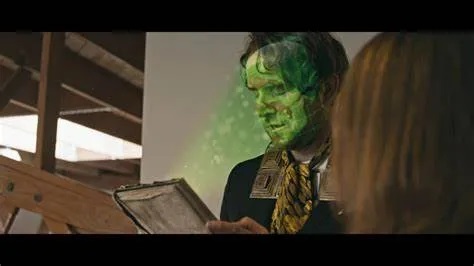
Screenshot from Sunspring, a short science fiction movie written entirely by AI, ArsTechnica, 2016.
The movie turned out to be weird and not quite understandable though 1. This is due to the fact that no coherent sentence, which in turn refers to a coherent image, can be generated without awareness of its logical sense, which is more than just understanding the language: it means understanding the situation, the context to which this language is applied. An algorithm can drive an AI to write in the style of an author, but when coming to original creation, this is another story.
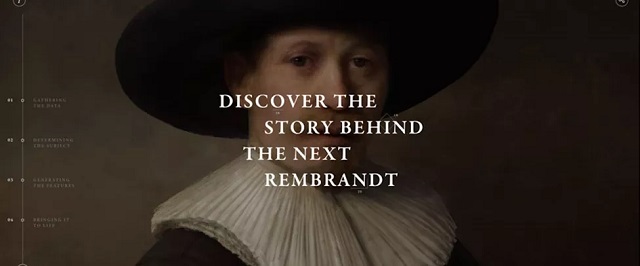
Screenshot from the website thenextrembrandt.com
Creativity
In 2016, a team from the Dutch museums Mauritshuis and Rembrandthuis, together with Microsoft, ING and the Delft University of Technology, brought together 346 Rembrandt paintings and digitized them using a learning algorithm. After 18 months of data analysis, the team created what is called an "AI-generated Rembrandt". The Next Rembrandt, this the name of the project, is the creation through artificial intelligence of a portrait that simulates Rembrandt's style with extreme accuracy, almost like a work that we could virtually add to the artist's catalog raisonné.
Also, the restauration of one of the most famous paintings by Rembrandt has been made by 3 artificial intelligences, with the help of a scientist restorer (not the opposite, and this is the whole point).
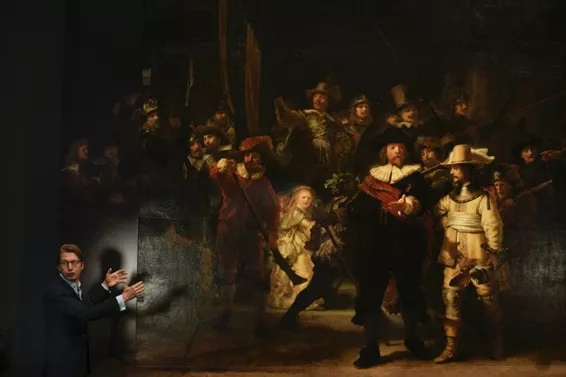
Rembrandt, The night watch, restored by Ai. Source: exhibart.com
And in 2018, the Christie auction house sold an artificial intelligence generated painting by the French collective Obvious for $ 432,500, earning 40 times the estimated price.
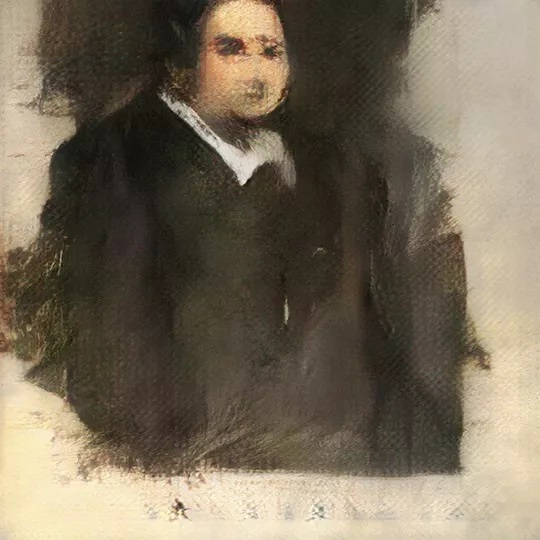
Obvious, Elmond De Belamy. Source: Artribune.com
An artificial intelligence system has found that Rubens' Samson and Delilah kept at the National Gallery in London is not authentic, confirming the perplexities that critics have been advancing for some time.
In the past, AI had "successfully" generated music in the style of Bach. The word "successfully" means that non-expert listeners could attribute the music to Bach. However, this was in reality a harmonization of an inputted melody that sounded like Bach.
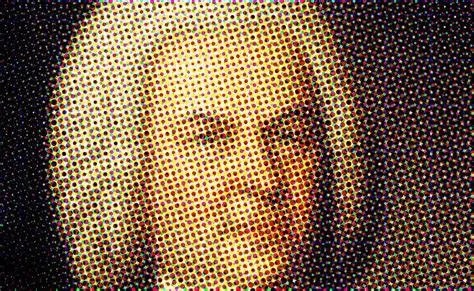
Last year a team of musicologists and Artificial Intelligences created, starting from few notes and scratches,
Beethoven's Symphony n. 10, presented to the public on October 21th, 2021, during a ceremony in Bonn.
The procedure got lot of critics between musicologists and passionate listeners, accusing the team to illicitly call it Beethoven's 10th symphony, where it's obvious that Beethoven is not the composer of that symphony.
In the literature field, there are many famous books that were published post mortem. From Kafka to Bulgakov, from Dickinson to Bolaño, Némirovsky, Larsson, to mention only few, it's a quite common practice to publish a manuscript after the death of the author. This is possible, though, because the work is finished, or almost finished. Nobody would write a book in the style of an author and attribute it to that author.
No matter if readers can't distinguish if it's real or not, this procedure is not philologically correct.
And, of course, nobody can tell what an artist had in mind to paint, compose or write, no matter how many other pieces of art they did before.
There is also another factor that matters: when an artificial intelligence makes some kind of art work, can it be considered as the author? And if yes, would the copyright be applicable to it?
Copyright
So, this is the main question: who is the author of a piece of work which is created by an Artificial Intelligence, an algorithm or, in other words, by a (very much evolute) computer? The question is not new, but lately it became more and more urgent.
Recently, there has been a discussion regarding the possibility for an Artificial Intelligence to be considered as inventor in a proceeding of patent registration.
The United States Patent and Trademark Office (USPTO) and European Patent Office (EPO) rejected the patent application filed by the developers of DABUS. The 2 applications included the name of Artificial Intelligence System DABUS as the inventor.
The Patent Office rejected the applications citing non-human inventors as ineligible for legal recognition.
Whilst the majority of courts denied the application, stating that the inventor can only be a natural person, in August 2021 a court in South Africa has issued the world's first patent that listed an AI inventor. Also, a first instance court of the Australian Federal Court has ruled that AI systems can be recognized as an inventor on patent applications.
For what pertains China, at present, the inventor of Chinese patent applications can only be a human being, although the Chinese Patent Law does not explicitly reject robots.
In fact, the Rule 13 of Implementing Regulations of the Patent Law of PRC states that "Inventor" or "Creator" referred to in the Patent Law means any person who makes creative contributions to the substantive features of an invention-creation. Also, the inventor should be an individual and not a unit or a collective.
For someone then, the AI can be an inventor: can it also be an author?
In general terms, the copyright laws around the world protect not the idea, but the expression of that idea. To be copyrightable, a work of art must be original, work of authorship and fixed in tangible form.
But who (what) can be defined as author? The word Author derives from the latin Auctor, which comes from augere, and literally means "who makes grow something". Author is then who originated or gave existence to anything and, more specifically, whose authorship determines responsibility for what was created.
If the first part of the sentence can be applied to AI, not the same can be done for the second: not being a legal entity, AI cannot take responsibility of the work created.
AI don't have any responsibility: in creating a painting, in driving a car, in listing your favorite songs, in playing chess or composing music, the AI is basically doing what the software algorithms drive it to do. This is the reason why the AI cannot be liable: it has no responsibility, no emotion, no intention.
When machines will be able to laugh at a joke or rejoice in a victory in chess, then they will also be responsible for their actions. But at the moment we are quite far from that.
In general terms, copyright protection only applies to works with human authors. Animals cannot be authors 2; vegetables cannot be authors. Artificial intelligence, being not human and not recognized as legal person, cannot be considered author for the purpose of copyright. At least until a judge decides differently.
The other important question is: who is the copyright owner of a work generated by AI?
It's not easy to answer.
The person who owns the copyright in a work is called the "copyright owner". Figuring out who's the copyright owner is sometimes tricky: it depends on the type of work, who made it, who it was made for, and whether it was sold. Also, it would depend on the country where the work of art was created and its legislation or jurisprudence.
Often the copyright belongs to the person who made the work, known as the author. For example, if a painter makes a portrait of you, he's the copyright owner of the painting. If he gives it to you, the painter still owns the intellectual right (copyright) of your portrait even though you own the physical portrait.
It's extremely common though that the copyright owner is different than the person who made the work.
Generally, you have to determine who owns a copyright on a case-by-case basis:
- Work for hire. Since works that are made within the duties of the employment or under a specific agreement belong to the employer/commissioner (unless otherwise agreed), the copyright might belong to the person or company who the work was made for.
- Assignment/license of copyright. The copyright owner may sell or license the rights to someone else through an assignment. This often occurs with musicians who are under contract with major record labels, or with writers and publishing houses.
- No copyright owner. There may have been no copyright at all, or the copyright may have expired (the so-called public domain).
For the AI generated work, one solution can be just denying the copyright, as it is seems some legislation in Europe does.
But Artificial Intelligence is already being used to generate works in music, journalism, art and gaming. These works may be deprived of copyright protection due to a lack of regulations.
Zach Naqvi 3 proposes 2 solutions: treating the AI as agents (basically as in the case of Work for hire), and treating the AI as consumer products in case the first way is not possible.
More explicitly: "Usually a company employs a team of programmers to develop AI. [...] Since the AI that the programmers create is a "work made by hire", they will not be able to have any copyright ownership over the AI code itself; instead, the principal will own the copyright."
"The principal-agency relationship cannot apply to certain AI products once the AI is sold as a consumer product, because the principal will lose control over the AI. In these cases, the copyright ownership can shift from the Ai creator to the AI controller – in other words, the principal will not own the copyright, but the end-user, who is typically a consumer, will own the copyright." 4
This may not be the perfect way, but the importance of the topic needs to be taken into account and the rapid development of Artificial Intelligence urges for a review of the jurisprudence.
Footnotes
1 See Movie written by algorithm turns out to be hilarious and intense, Ars Technica, June 2016. https://arstechnica.com/gaming/2021/05/an-ai-wrote-this-movie-and-its-strangely-moving/
2 You might recall the famous "Monkey selfie copyright dispute", where a photographer, David Slater, let a monkey use his camera, and the animal took some selfies later published in a book by Slater and described as "sign of self-awareness".
3 Zack Naqvi, AI, Copyright and Copyright infringement, 24 Marq. Intellectual Property L. Rev. 1, (2020), pp.16-51, spec. p. 30-38.
4 Zack Naqvi, p. 30; 34.
The content of this article is intended to provide a general guide to the subject matter. Specialist advice should be sought about your specific circumstances.


